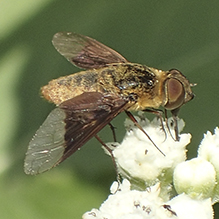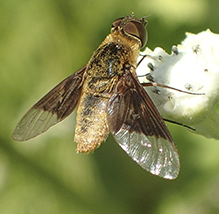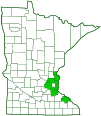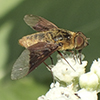bee fly
(Chrysanthrax cypris)
Conservation • Description • Habitat • Ecology • Distribution • Taxonomy
|
|
||||||||||||||
Description |
Chrysanthrax cypris is a showy, medium sized to large, banded bee fly. It occurs in the United States from New Jersey to Florida, west to southern Minnesota and eastern Texas. It also occurs in Mexico and Central America. It is most common in the East Coast and Gulf Coast states. Though not widespread in Minnesota, it was reported as common at Cedar Creek Ecosystem Science Reserve in Anoka County. Adults are most active in mid-summer, July and August. They are found in dry, open, sunny areas. They can be seen flying over flowers or resting on the ground, basking in the sun. They feed on flower pollen. The larvae are parasites of tiphiid flower wasps (family Tiphiidae). Adults are stout-bodied, hairy, and 5⁄16″ to ⅝″ (8 to 15 mm) in length. The antennae are shorter than the head, and they have three segments. The third segment (flagellomere) is cone-shaped, and it has a slender appendage (style) at the tip. The rear margin of each compound eye is strongly indented. The tube-like mouthpart (proboscis) is short, extending less than the length of the antennae. The abdomen is black. The upper side is covered to a variable amount with yellow and orange hairs. The sides are densely covered with soft, woolly, orange hairs. There are no white bands. The wings are as long as the abdomen. The basal half is dark brown, and it is sharply divided from the clear outer half. The dark area does not have spots or clear windows. vein M1 ends behind the wing tip. vein R2+3 has a single curve near the end. It is not connected to vein R4. The discal cell is present and there are four posterior cells. The anal cell is open at the wing margin. The last part of each leg (tarsus), corresponding to the foot, has five segments. There is a pair of claws at the end of the last segment, and there are two pads at the base. The pads are rounded, not tooth-like. On the front legs, the fourth segment (tibia) does not have long bristles, and the claws are shorter than on the other legs. |
Size |
Total length: 5⁄16″ to ⅝″ (8 to 15 mm) |
Similar Species |
Habitat |
Dry, open, sunny areas |
Ecology |
Season |
July and August |
Behavior |
|
Life Cycle |
|
Larva Hosts |
Tiphiid flower wasps (family Tiphiidae) |
Adult Food |
Flower pollen |
Distribution |
||
|
Sources |
|
| 5/30/2024 | ||
Occurrence |
||
|
||
Taxonomy |
|
Order |
|
Suborder |
Brachycera |
Infraorder |
Orthorrhapha |
Superfamily |
Asiloidea |
Family |
Bombyliidae (bee flies) |
Subfamily |
Anthracinae |
Tribe |
villini (banded bee flies) |
Genus |
Chrysanthrax |
Subordinate Taxa |
|
|
|
Synonyms |
|
Anthrax conifacies Anthrax cypris Anthrax fulvohirta |
|
Common Names |
|
This species has no common name. The common name of the Family Bombyliidae is bee flies, and it is used here for convenience. |
|
Glossary
Proboscis
The tube-like protruding mouthpart(s) of a sucking insect.
Style
On plants: Part of the pistil, usually a slender stalk, connecting the ovary to the stigma(s). On flies (Diptera): A terminal, often slender or pointed, appendage arising from the end of the last, usually third, antennal segment.
Tarsus
On insects, the last two to five subdivisions of the leg, attached to the tibia; the foot. On spiders, the last segment of the leg. Plural: tarsi.
Tibia
The fourth segment of an insect leg, after the femur and before the tarsus (foot). The fifth segment of a spider leg or palp. Plural: tibiae.
Visitor Photos |
||
Share your photo of this insect. |
||
This button not working for you? |
||
Babette Kis |
||
 |
 |
|
Chrysanthrax cypris golden-backed bee fly Chrysanthrax cypris, a golden-backed bee fly, is a stunning fly with golden hairs on its thorax and abdomen. The photos attached are of a somewhat worn fly, which had lost some of its golden hairs. This quick-moving fly was on wild quinine at Barnes Prairie, Racine Co., WI. Photo was taken on July 30, 2022. |
||
MinnesotaSeasons.com Photos |
||
|
||
|
||

Slideshows |
|

Visitor Videos |
||
Share your video of this insect. |
||
This button not working for you? |
||
|
Other Videos |
||
|

Visitor Sightings |
||
Report a sighting of this insect. |
||
This button not working for you? |
||
MinnesotaSeasons.com Sightings |
||
|

|
Created: 5/30/2024 Last Updated: © MinnesotaSeasons.com. All rights reserved. |

